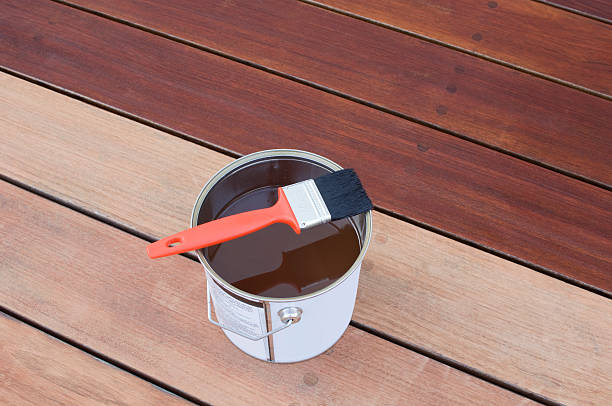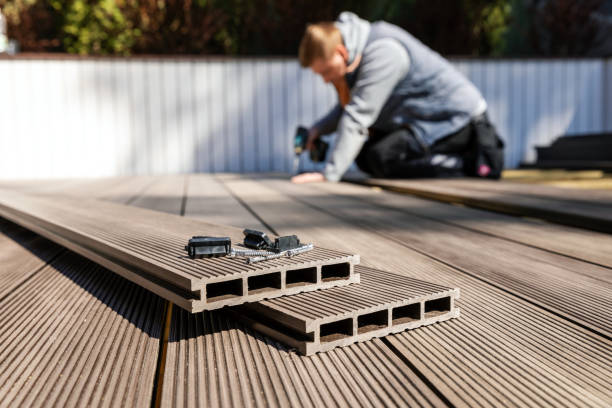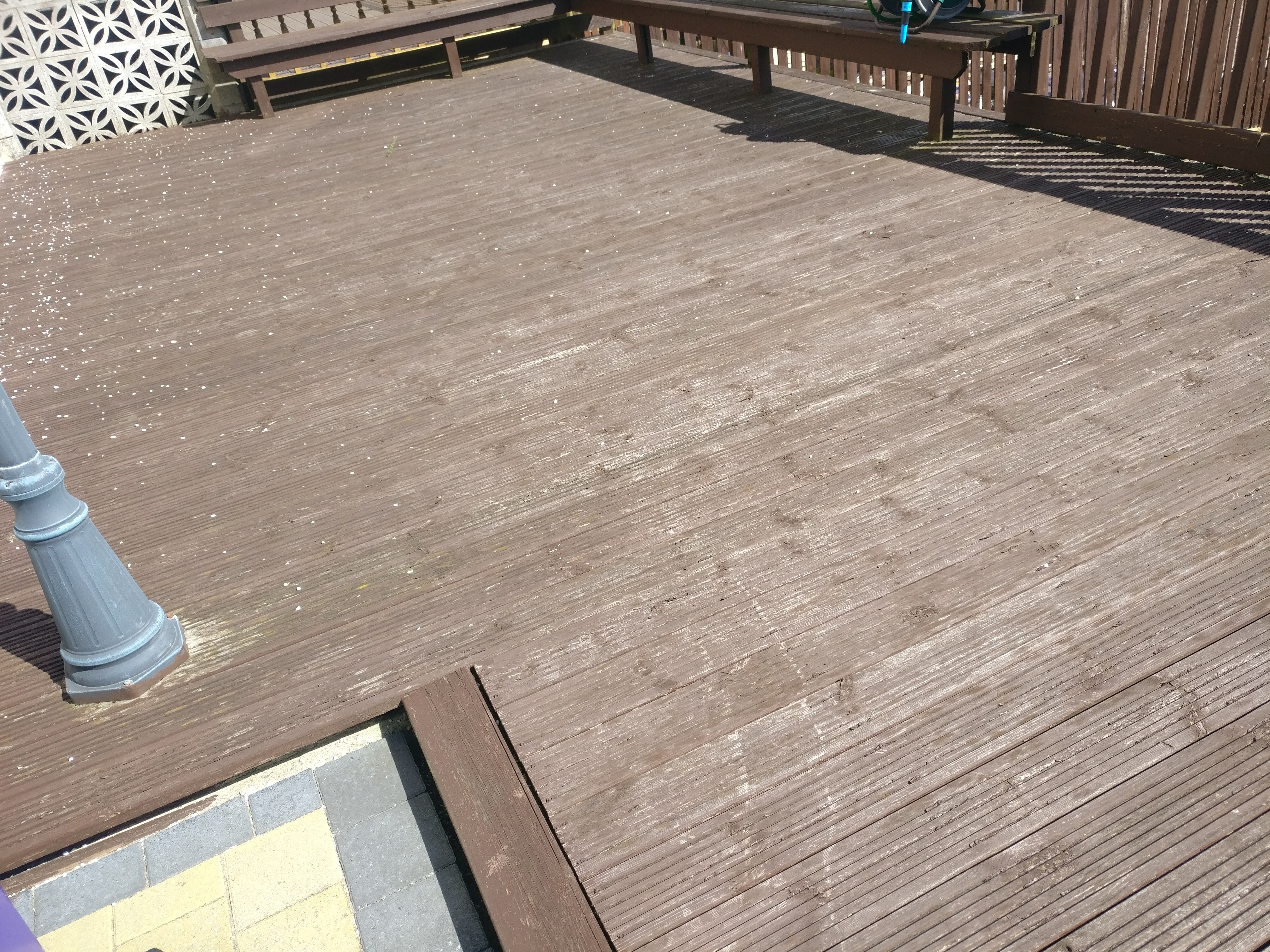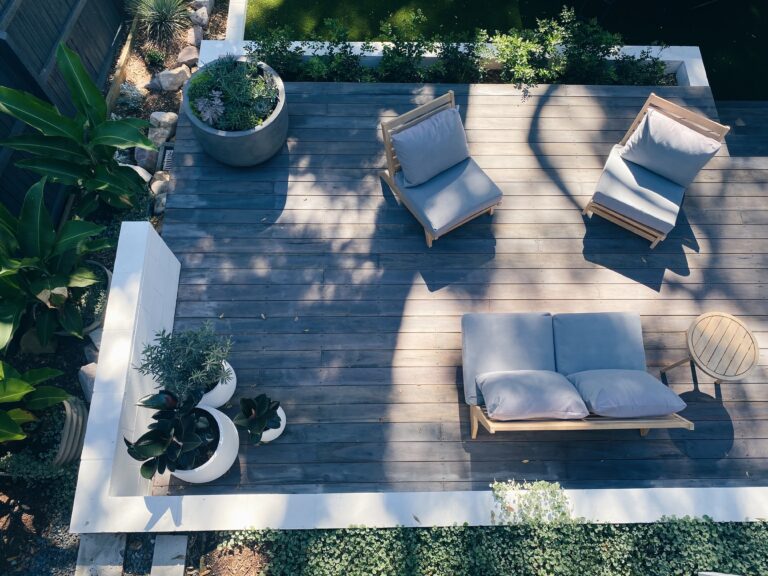Composite decking is popular for outdoors. But it has problems. Knowing these issues can help people pick the right one and maintain it.
Fading or discolouration can happen due to sun or weather. To stop this, choose a composite that has UV protection. Also, clean and seal it regularly.
Mold and mildew can grow on damp decks. To prevent this, keep it clean and dry. Sweep away leaves and debris and power wash with a gentle detergent.
Scratches and dents can come from furniture and objects. Avoid dragging heavy items and use pads under furniture legs. If there are scratches, sand gently or use a kit provided by the manufacturer.
Thermal expansion and contraction can cause warping or buckling. To stop this, follow installation guidelines with enough spacing for natural expansion and contraction. This will keep the deck stable.

Problem 1: Fading Color
Composite decking may have some common issues, one of which is color fading. This is when the vibrancy and intensity of the deck’s color decreases over time.
- Sunlight and UV rays can cause color fading.
- Low-grade composite decking materials fade more easily.
- Darker colors absorb more heat from the sun and this worsens fading.
- Neglecting regular cleaning or inadequate coatings can also speed up fading.
- Exposure to moisture or inadequate ventilation can lead to color fading.
It’s noteworthy that some manufacturers have created technologies and materials that limit fading color. For instance, certain brands offer fade-resistant composites that last longer.
Consumer Reports did a survey and found that low-grade composite decking tends to fade faster than the higher-quality ones. Thus, it is essential to do research and pick reliable brands with long-lasting, fade-resistant composite decking options.
Problem 2: Mold and Mildew Growth
Mold and mildew can take over composite decking if it’s not taken care of. It’s important to address this quickly, or else it could damage the deck’s quality and appearance.
– Mold and mildew love damp and humid spots. So, composite decking is at risk.
– Poor venting and too much moisture can cause mold and mildew to appear.
– The look of the deck will suffer and it can be a health hazard.
– Cleaning and maintaining the deck is necessary to prevent mold and mildew growth.
– Use a bleach cleaner or vinegar and water to remove existing mold and mildew.
– Applying a protective sealant can stop mold and mildew from coming back.
It’s important to take action against mold and mildew, or it can cause long-term damage to the composite decking boards. To reduce the chance of mold and mildew growth, make sure there’s proper drainage, allow air to flow through, and deal with any signs of moisture quickly.
Problem 3: Warping and Cracking
Warping and cracking are common problems with composite decking. They can be caused by temperature fluctuations, moisture, or bad installation. To understand this better, here is some data:
| Factors | Warping | Cracking |
|---|---|---|
| Temperature | High | Moderate |
| Moisture Exposure | Low | High |
| Installation | Improper | Rare |
High temperatures for long periods can cause warping. So, be careful if you’re in a region with extreme climates. Moisture exposure means more cracking. If you live in a damp or humid area, this is something to think about.
Proper installation is key for avoiding warping and cracking. Incorrect fastening or bad spacing between boards can cause problems. It’s a good idea to follow the manufacturer’s instructions and get help from professionals.
Finally, research finds that composite decking is less likely to warp or crack than traditional wood decking. That makes it a great pick for homeowners looking for a tough and lasting outdoor decking solution.
Problem 4: Stains and Discoloration
Stains and discoloration on composite decking are common. They can make the deck look old and unattractive. Sunlight, moisture, and organic materials like leaves and dirt can all contribute to this issue.
Let’s look at some specific examples of stains and discoloration that may occur:
| Issue | Cause |
| Fading | Ultraviolet rays |
| Mold and Mildew | Moisture and organic debris |
| Food or Beverage Stains | Spills not cleaned fast |
| Rust Stains | Metal objects left in contact |
Low-quality materials or poor installation techniques can make decks more prone to staining and discoloring. Choose good quality products with protective coatings or finishes to minimize the problem.
Sarah had an expensive composite deck in her backyard. But due to too much sunlight and lack of care, it started fading and growing mold. This affects both the aesthetics and lifespan. Sarah learned the importance of regular cleaning and protection for preventing staining and discoloration on composite decking.
Problem 5: Slippery Surface
Slippery surfaces can be a problem with composite decking. This poses a safety risk, particularly when wet or icy. Let’s look at the table:
| Problem | Slippery Surface |
|---|---|
| Description | The surface of composite decking can become slippery. It can happen when exposed to moisture, like rain or snow. This can cause accidents. |
| Causes |
|
| Solutions |
|
It’s not just composite decking that can have a slippery surface. Traditional timber decking can too, if not maintained properly.
Many people have had accidents because of slippery decks. Stories of slipping and hurting themselves on composite decks have been shared.
It’s important to be aware of slippery surfaces and take precautions. By using the right materials and maintaining it well, one can make sure they are safe.
Problem 6: Lack of Durability
A homeowner’s composite decking in their backyard had them initially pleased with its low-maintenance features. However, after just a few years, signs of deterioration started to show. Warping, fading, and even rot all became part of the package. It was a lesson in the fact that, no matter what the manufacturer promises, you must consider all aspects of composite decking before investing in a project.
To reduce the lack of durability, regular cleaning and maintenance can help hinder moisture damage, fading, and mold growth. Also, using protective coatings or sealants can protect against scratches and stains.

Problem 7: High Maintenance Requirements
Composite decking is great for outdoor spaces, but it requires high maintenance. To get a better understanding of this, let’s delve deeper.
Cleaning: Regular cleaning is a must. To remove dirt, debris, and stains, use a mild detergent or a specially formulated deck cleaner. Follow the manufacturer’s guidelines to avoid damaging the surface.
Staining & Sealing: Unlike wood decking, composite decks don’t need to be stained or sealed. But, if you want to protect the color or prevent fading, there are stain and sealant options designed for composite materials.
Scratches & Scuffs: Composite decking is more scratch-resistant than wood, but it can still get scratched or scuffed. To reduce risk, use furniture pads or protective mats under heavy items and avoid dragging sharp objects across the deck.
Mold & Mildew: In damp or humid climates, mold and mildew can be an issue on any outdoor surface, including composite decking. Clean regularly with a mold and mildew remover to prevent growth and keep your deck looking pristine.
To maintain your composite decking effectively, here are some suggestions:
- Regular Maintenance: Set up a schedule for cleaning twice a year. This will help prevent dirt buildup and prolong its lifespan.
- Use Proper Cleaning Products: Stick to manufacturer-recommended products to avoid damaging the deck. Pressure washers and abrasive cleaners can cause irreversible damage.
- Protect the Surface: Place furniture pads or mats under heavy items to prevent scratches or scuffs. Discourage the use of sharp objects on the deck.
- Keep it Dry: Ensure proper drainage around the deck to avoid excessive moisture buildup. Remove any standing water promptly.
By following these suggestions, you can maintain your composite decking and enjoy its beauty for years. Remember, regular cleaning, protecting against scratches, and preventing mold and mildew are key to ensuring longevity.
Conclusion
Wrapping up: there are troubles with composite decking. These include fading, staining, mold and mildew growth. Consider these before buying. Warping and cracking can occur due to temperature change.
Choose a high-quality material designed to resist fading and staining. Clean and maintain regularly to avoid mold and mildew. Follow manufacturer guidelines for installation to avoid warping/cracking. This may include proper spacing between boards and ventilation below the deck.
Frequently Asked Questions
FAQs:
1. How long does composite decking last?
Composite decking has a longer lifespan compared to traditional wood decks. On average, it can last anywhere between 25 to 30 years, depending on the quality of the material and maintenance.
2. Can composite decking fade in color over time?
While most composite decking is designed to resist fading, some lower-quality products may experience slight color changes due to exposure to sunlight and the elements. However, reputable brands often offer fade-resistant warranties and technology to minimize fading.
3. Are composite decks prone to mould or mildew?
Composite decking is resistant to mould and mildew, but it can still develop in certain conditions. Regular cleaning and maintenance, including keeping the deck dry and free of debris, can prevent mould and mildew growth.
4. Can composite decking be stained or painted?
Unlike wood decking, composite decking cannot be stained or painted as it is made with a combination of wood and plastic fibers. The color options available during purchase are generally long-lasting and won’t require additional painting or staining.
5. Is composite decking susceptible to scratches?
Composite decking is designed to be more durable and resistant to scratches compared to traditional wood decks. However, excessive wear or dragging heavy objects may cause some scratches. Regular cleaning and avoiding sharp objects on the deck surface can help minimize this issue.
6. Can composite decking boards warp or bend?
Composite decking is engineered to have better dimensional stability and is less likely to warp or bend compared to wood. However, extreme temperature changes or improper installation can contribute to slight warping. Following the manufacturer’s installation guidelines can help prevent this problem.
{
“@context”: “https://schema.org”,
“@type”: “FAQPage”,
“mainEntity”: [
{
“@type”: “Question”,
“name”: “How long does composite decking last?”,
“acceptedAnswer”: {
“@type”: “Answer”,
“text”: “Composite decking has a longer lifespan compared to traditional wood decks. On average, it can last anywhere between 25 to 30 years, depending on the quality of the material and maintenance.”
}
},
{
“@type”: “Question”,
“name”: “Can composite decking fade in color over time?”,
“acceptedAnswer”: {
“@type”: “Answer”,
“text”: “While most composite decking is designed to resist fading, some lower-quality products may experience slight color changes due to exposure to sunlight and the elements. However, reputable brands often offer fade-resistant warranties and technology to minimize fading.”
}
},
{
“@type”: “Question”,
“name”: “Are composite decks prone to mould or mildew?”,
“acceptedAnswer”: {
“@type”: “Answer”,
“text”: “Composite decking is resistant to mold and mildew, but it can still develop in certain conditions. Regular cleaning and maintenance, including keeping the deck dry and free of debris, can prevent mold and mildew growth.”
}
},
{
“@type”: “Question”,
“name”: “Can composite decking be stained or painted?”,
“acceptedAnswer”: {
“@type”: “Answer”,
“text”: “Unlike wood decking, composite decking cannot be stained or painted as it is made with a combination of wood and plastic fibers. The color options available during purchase are generally long-lasting and won’t require additional painting or staining.”
}
},
{
“@type”: “Question”,
“name”: “Is composite decking susceptible to scratches?”,
“acceptedAnswer”: {
“@type”: “Answer”,
“text”: “Composite decking is designed to be more durable and resistant to scratches compared to traditional wood decks. However, excessive wear or dragging heavy objects may cause some scratches. Regular cleaning and avoiding sharp objects on the deck surface can help minimize this issue.”
}
},
{
“@type”: “Question”,
“name”: “Can composite decking boards warp or bend?”,
“acceptedAnswer”: {
“@type”: “Answer”,
“text”: “Composite decking is engineered to have better dimensional stability and is less likely to warp or bend compared to wood. However, extreme temperature changes or improper installation can contribute to slight warping. Following the manufacturer’s installation guidelines can help prevent this problem.”
}
}
]
}







